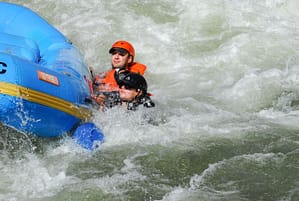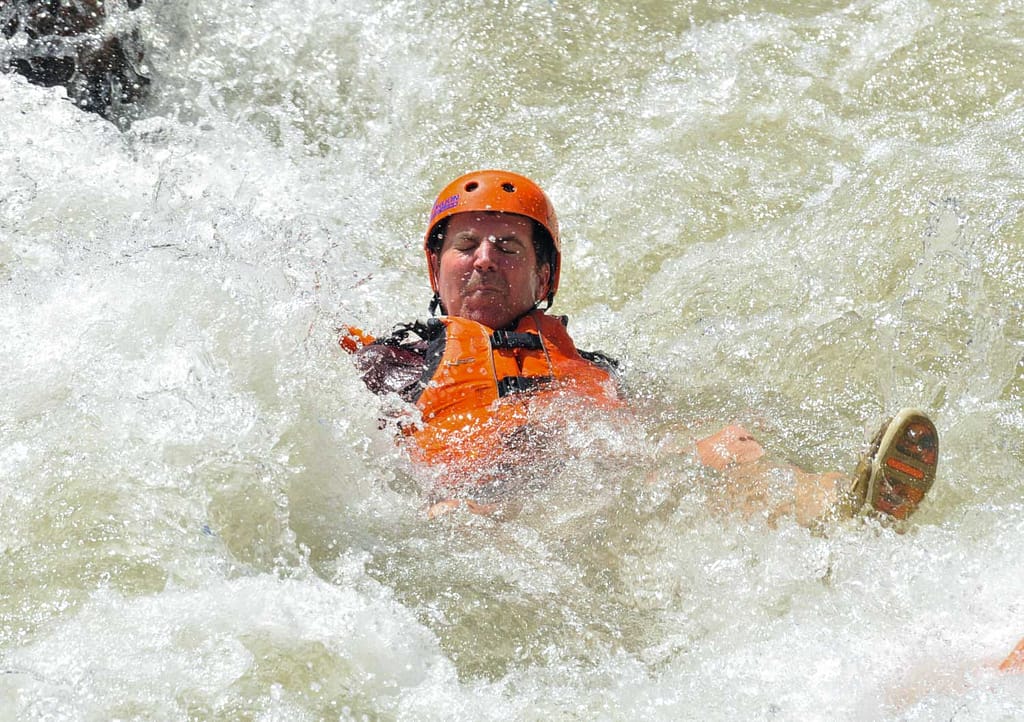 It can’t be denied that white water rafting is a lot of fun. Yet, to maximize your enjoyment of the river, you must abide by certain safety protocols. This means not only having the right equipment like personal flotation devices (PFD), but also knowing how to handle yourself in case of falling out white water rafting.
It can’t be denied that white water rafting is a lot of fun. Yet, to maximize your enjoyment of the river, you must abide by certain safety protocols. This means not only having the right equipment like personal flotation devices (PFD), but also knowing how to handle yourself in case of falling out white water rafting.
While falling out of the raft is a common occurrence in white water rafting, it can be dangerous if you don’t know how to handle the situation. White water rafting risks are not only prevalent at high-water flows – inherent risk is involved regardless of when you raft due to the nature of the sport.
To help educate our guests on safety, Echo Canyon put together this brief guide on how to handle falling out white water rafting.
 If you fall out of the raft, the first thing you should be concerned about is your immediate safety. Your first move should always be to try and grab the raft or something attached to the raft. Even more, holding onto your paddle will provide an extension of your reach, while also ensuring this important tool is not lost downstream.
If you fall out of the raft, the first thing you should be concerned about is your immediate safety. Your first move should always be to try and grab the raft or something attached to the raft. Even more, holding onto your paddle will provide an extension of your reach, while also ensuring this important tool is not lost downstream.
When reaching for the raft, keep your eye out for any strap, rope, or handle that could aid in getting back to the boat. Consider using your paddle as an extension of your reach. Also, if there are other people on the raft, they will likely reach for you to assist in the situation. Once next to the raft, position yourself facing the boat so people can pull you on board using your PFD.
If you are separated from your raft and can’t quickly get back to it, then your best bet is to swim to another raft if it is closer. If the shoreline is closer than your raft or other rafts, then swim to shore. While swimming, it’s important to keep your bearings with downstream obstacles and shoreline obstacles. Swim with your head above water at all times, and it’s nearly always advisable to avoid swimming headfirst downstream. Also, keep your feet up. If you get tired or need to pause to avoid swimming into an obstacle, ensure your feet are not dangling in the water – this can put you at risk for foot entrapment. More on that below.
Once you get close to shore, resist the urge to stand up until the river is shallow enough that you can touch the bottom of the river with your hands. Crawl all the way out of the river and remain in one place so your guides can find you and escort you back to a raft.

 If you’ve fallen into the river and cannot immediately get back to the raft, and if the whitewater is too rapid to feasibly swim to shore, then laying on your back, face up, with your feet downstream is okay for a short amount of time. Since you will be floating downstream with the current, it’s important you position your body to lessen any chance of injury.
If you’ve fallen into the river and cannot immediately get back to the raft, and if the whitewater is too rapid to feasibly swim to shore, then laying on your back, face up, with your feet downstream is okay for a short amount of time. Since you will be floating downstream with the current, it’s important you position your body to lessen any chance of injury.
Bring your feet up to the surface of the water – this is important. Not only will keeping your feet on the surface help avoid getting trapped by underwater objects causing what’s known as foot entrapment, but it also gives you a way to brace for potential impacts with rocks. Foot entrapment is when your foot, ankle, or lower leg becomes stuck in rocks or other debris below the surface of the river. If this occurs and the water is deeper than your arms are long, you will not be able to hold your head above water. This is an exceptionally dangerous situation for you and your rescuers, so it’s to be avoided at all costs. If there’s one thing you should never forget when engaging in river sports, it’s that you should never ever stand up in the river.
 Anytime you unexpectedly find yourself in the water, it’s important to face downstream so you can react to the obstacles you are travelling toward. Turning your body in this fashion will keep your head far from any potential impact zones. Even more, your river shoes can be used to absorb any contact with rocks and other objects.
Anytime you unexpectedly find yourself in the water, it’s important to face downstream so you can react to the obstacles you are travelling toward. Turning your body in this fashion will keep your head far from any potential impact zones. Even more, your river shoes can be used to absorb any contact with rocks and other objects.
As you float downstream, keep your arms out from your body and use them to help maneuver your body when necessary. Continue to keep your eye on the raft as you work your way closer to the boat by paddling your arms. If the current is too strong, continue to float in the feet up position until conditions settle down. But don’t wait until the river is totally calm. You are only in this position long enough for the roughest of rapids. As soon as you can feasibly swim to your raft, another raft, or the shoreline, it’s important you take action and swim to safety.
Your raft guide has your best interest in mind, so it’s important to listen to them when they are delivering the pre-trip safety orientation and paddle instruction. Even if you find yourself in the river, guides will continue to either shout directions to you as they point in the direction you should swim.
Important Note: This information is not a complete list of actions every swimmer should take, but rather to relay some of the more important points you will also hear in your pre-trip safety orientation. Reading this web page does not prepare you for your rafting trip.
While white water rafting is extremely fun, the river should be treated with respect. If you have more questions about what happens if you fall out white water rafting, Contact Us today.
News & Deals
"*" indicates required fields